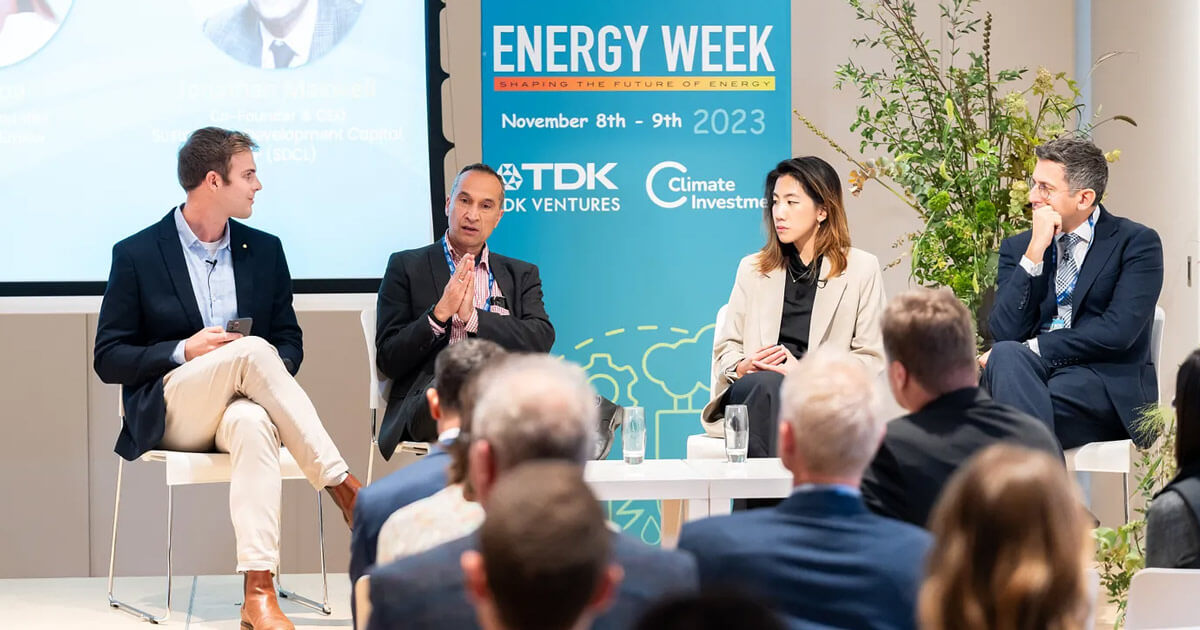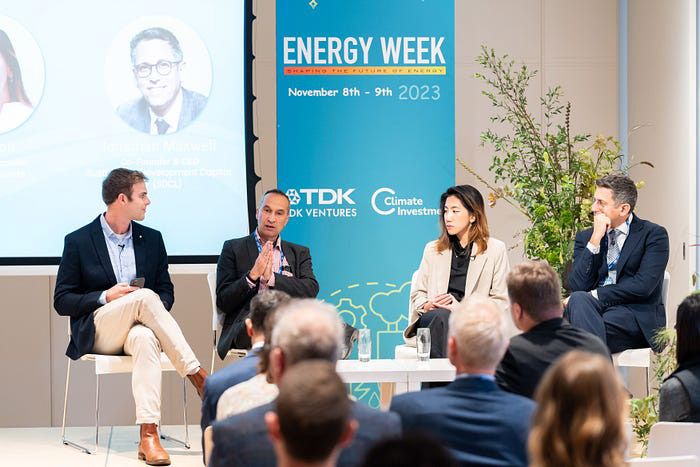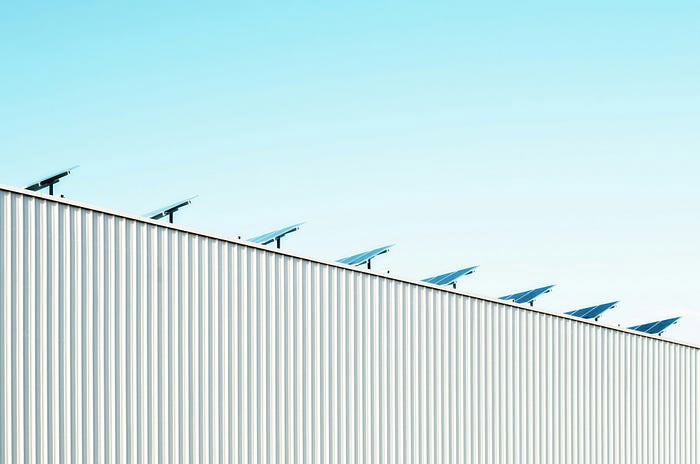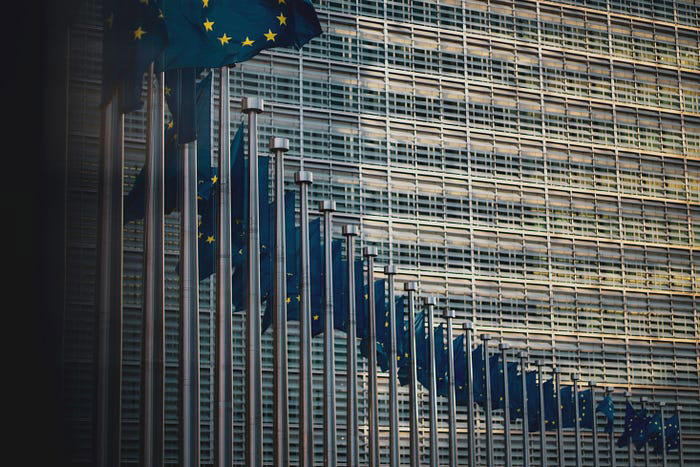Introduction
Capital, Implementation to Solve the Last Two Energy Trilemma Components
Moving Beyond Efficiency
The energy mix, at least in the many European countries, has entered a new phase.
“We have done a lot of the easy things, and they didn’t cost a lot,” says. Nilay Shah, professor of process systems engineering at Imperial College, London, and director of Zero Petroleum Ltd, referring to broad European pushes for efficiency improvement in the energy space historically.
Kicking off the panel discussion of “The Future of the European Energy Mix” before a live and online audience gathered for Energy Week 2023 presented by TDK Ventures and Climate Investment, Shah said that the world has largely identified and begun implementing energy sustainability and efficiency solutions. But as the focus shifts to energy security and affordability, new challenges emerge.
Kim Zou, CEO and co-founder of Sightline Climate, agreed. “We’re seeing a shift from both commitments and venture capital to deployment and execution of batteries, EVs, storage, and solar even. Technologies that used to be early stage.”
Shah noted that, “in moving to the next step — around industrial and transport system decarbonization, more electrification of the economy, upgrading electrical grids and making them smarter — there’s a lot more hesitation politically and in society. That’s partly because it’s an activity where you have to get over a hump before you see enormous benefits.”
That hump entails building the capital resources, and while society in general and the engineering community have developed a workable road map for surmounting it, a phase of massive investment is required. Shah says that investment is needed not so much from the venturing community but more from project and infrastructure finance, and integrating then scaling known technologies.
The third member of the panel, Sustainable Development Capital founder and CEO, Jonathan Maxwell, noted that 80 percent of energy comes from oil, gas, and coal, and more than two-thirds of that non-electrical energy is wasted.
“After we extract it, we lose 10 percent (refining) it into something that’s useful,” he explained. “We put it in a turbine and half of it goes up into heat. You’ve lost 60 percent of primary energy before it leaves the power station. And you lose another 5 to 10 percent in transmission and distribution.”
The maddening part, he said, is that large-scale solutions to this problem have existed for years.
“Ten years ago, people weren’t really talking about LEDs; now, it’s the most obvious thing, but still most hospitals (in England) haven’t got it,” Maxwell said. “That’s crazy, but lighting is just the tip of the iceberg. The big pieces will be in heating and cooling. That can be transformed to all levels of low-temperature (commercial buildings and homes), medium-temperature (manufacturing), and very high-temperature (pharmaceuticals and chemicals). We know how to do this stuff. We knew about them 15 years ago, and they have become bigger and more commercially deployed and acceptable.”
Photo by Scott Webb on Unsplash
Re-aligning capital and supply chains
The other major issue when it comes to Europe’s Energy mix in the coming decades, Zou said, is that the continent is diverse and use cases will be fragmented. She said a global energy mix approach is too broad. Instead, we should zoom in on local-, company-, or solution-level abatement and economic perspective. These will differ according to geographic region and use case.
“Wind, solar, battery storage — technologies toward the mature stage — are going to be the stars of the show, at least in the near-term, in ensuring reliability,” she conceded. “But, when we think about the energy mix and broader climate (issues), it’s easy to zoom in on all the technologies (in a search for) the silver bullet. Which one will win out? Is it going to be nuclear? Is it going to be hydrogen? But it’s less about which technology will win the race. It’s an all-solutions play. The focus should be on abatement but also on cost. There are tradeoffs to all these solutions.”
” The panel next addressed supply chain issues, with Maxwell calling for energy generation closer to where it is needed. That is “one big thing you can do without fundamentally changing any technology or using anything that hasn’t been used for the last 50 or 70 years,” he said. “No matter how it’s generated, if you’re capturing heat and using it on-site, you’re not wasting most of it in getting it from over there to over here.”
That application is complicated, however, by the placement and availability of renewable energy sources. Shah noted that many rich hydro, wind, and solar fields are located some distance from any population or industrial centers, and that re-thinking the next generation of energy carriers may be essential to enabling more efficient generation and consumption.
“A lot of developers have licenses, plans, and permits, creating a massive queue for grid connections,” he said. “The grid is the marketplace for selling the electrons you make. We see an opportunity in liquid fuels — think of a (descending) hierarchy of liquified hydrogen, ammonia, methanol, hydrocarbons. It’s more complicated to make hydrocarbons, but once you’ve made them the supply chain is quite easy. It’s fungible and the transport costs are not huge. So, you don’t have to make it at the market. You’re better off making it where you have that very cheap, but somewhat stranded, renewable energy.”
Sourcing for geothermal energy, at least, may be less of a concern than previously thought. Zou said notions that geothermal “only works in Iceland or regions with that geographic characteristic” may be belied by Eavor’s 8MW project in Germany. That project intends to become one of the first commercial deployments for closed loop geothermal approaches which enable a broader set of geological resources to be leveraged for energy production.
“It can be a source of both power and heat,” she noted. “We might see more of it if that project is successful.”
She also led the discussion towards solutions that tackle demand reduction and grid flexibility that are gaining momentum as more renewable energy sources join the supply mix.
“A lot of early-stage investors are focusing on how we can switch to broader electrification, such as heat pumps, district heating networks, one-stop shop-installation companies doing solar and EV charging,” Zou explained. “Now that the European energy market is more liberalized, you’re seeing the rise of (virtual power plants and distributed energy resources). There is less hard tech/deep tech innovation and more rational balance of supply and demand that allows clean supply to come onto the grid with these technologies deployed.”
Photo by Christian Lue on Unsplash
Governments and geopolitics in the mix
Maxwell noted that in October 2022, the European Commission mandated that all member states cut gas use by 15 percent by 2030. The seven-year compliance timeline, he said, shows the continent is not serious about meeting this huge challenge. Energy security is one big reason. Maxwell said he consulted with an EU member seeking pragmatic ways to bring additional energy capacity onto its network without much regard to carbon intensity.
“Because of the Russia-Ukraine crisis and the disruption of northeast European gas transmission, their big plan, which I can’t argue with, is to put more oil into the system for storage so they can think about oil to electricity,” he said. “We’re going back a little bit in the UK and Europe. There’s a huge problem with security and cost. We’re buying as much natural gas as we can from the United States and other markets, and it’s going to get more disruptive and expensive, because we will not have really serious generation capacity for the next 10 to 20 years.”
All three panelists agreed that governments must take a leading role in spurring both technology development and adoption.
Shah is hopeful that tax schemes can provide mechanisms for governments to encourage industry to adopt academia’s ideas and translate them into industry, especially in analyzing the value chain to uncover inefficiencies, and finding the practices, innovations, and market systems to eliminate them.
“Move away from taxing work and toward taxing inefficiency,” he suggested. “You need people to work on different things and investors to fund different technologies. You’re potentially changing the way labor works. So, tax inefficiency in the use of virgin materials and heat dumping and reduce taxes on labor.”
Maxwell says regulation is the silver bullet.
“If a company wastes money on energy, which they do, nobody knows, let alone cares or complains,” he explained. “We need disclosure and regulation. If you don’t think it’s OK that businesses and the government waste money on energy, then regulators should force them to cut their energy use per unit of GDP output by X.”
China introduced this concept in 2006. Beijing’s 4 percent target is the number Europe is adopting — 16 years later.
Zou sees government capital as one lever for fully decarbonizing the grid and providing a bridge to bankability.
“In the US there’s all this talk about the Inflation Reduction Act and Jigar Shaw (director of the US Department of Energy’s Loan Programs Office) having $400 billion in loans to deploy,” she said. “In Europe, we’re seeing that catalytic capital coming in different shapes and sizes: country-level subsidies and grants, European Investment Bank serving as an LPO of sorts, as well as private institutional capital.”
Shah added that governments can use procurement to aggressively increase renewable and low-carbon content in the energy and materials mix, which would create value chains and cashflow for innovative companies.
“That could spark rapid adoption of innovative venture-capital structure, financing, and capital formation that helps scale technology along with its deployment,” Zou said. “Venture capital helps entrepreneurs shift technology risk. Now, we’re thinking about project finance, infrastructure, and how to fill that gap and build the bridge to bankability for projects, commercial debt, and asset financing outside of corporate equity.”
An immense thank you to Prof. Shah, Kim, and Jonathan for their invaluable insights in this panel, and to our guests and attendees for their attendance and excellent questions.
TDK Ventures and Climate Investment hosted Energy Week 2023 at London’s Goldsmiths’ Center to highlight the efforts of industry entrepreneurs, investors, and the scientific community in solving the world’s energy challenges and finding sustainable paths to decarbonization.
Energy Week 2023 featured industry leaders, experts, and visionaries, who are shaping the future of the energy landscape to help explore the latest advancements, challenges, and opportunities in sustainable energy solutions.
TDK Ventures Inc. invests in startups to bolster innovation in materials science, energy, power and related areas typically underrepresented in venture capital portfolios. Established in 2019 as a wholly-owned subsidiary of TDK Corporation, the corporate venture company’s vision is to propel the digital and energy transformations of segments such as health and wellness, next-generation transportation, robotics and industrial, mixed reality and the wider IoT/IIoT markets.
Climate Investment is an independent organization founded by members of the Oil and Gas Climate Initiative, specializing in accelerating capital-efficient decarbonization in high-emission sectors. Since 2017, they have curated a portfolio of over 30 innovative technologies and business models, resulting in a cumulative reduction of 57 MT CO2e in greenhouse gas emissions from 2019 to 2022.





